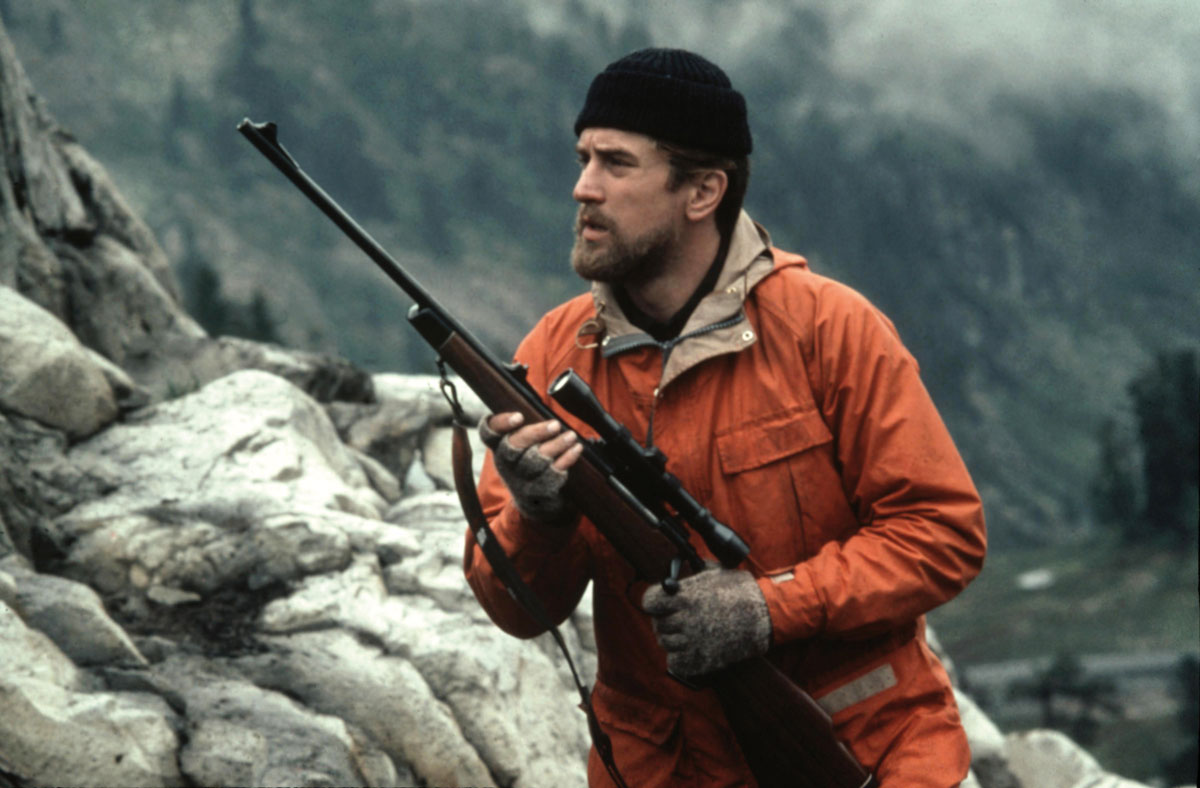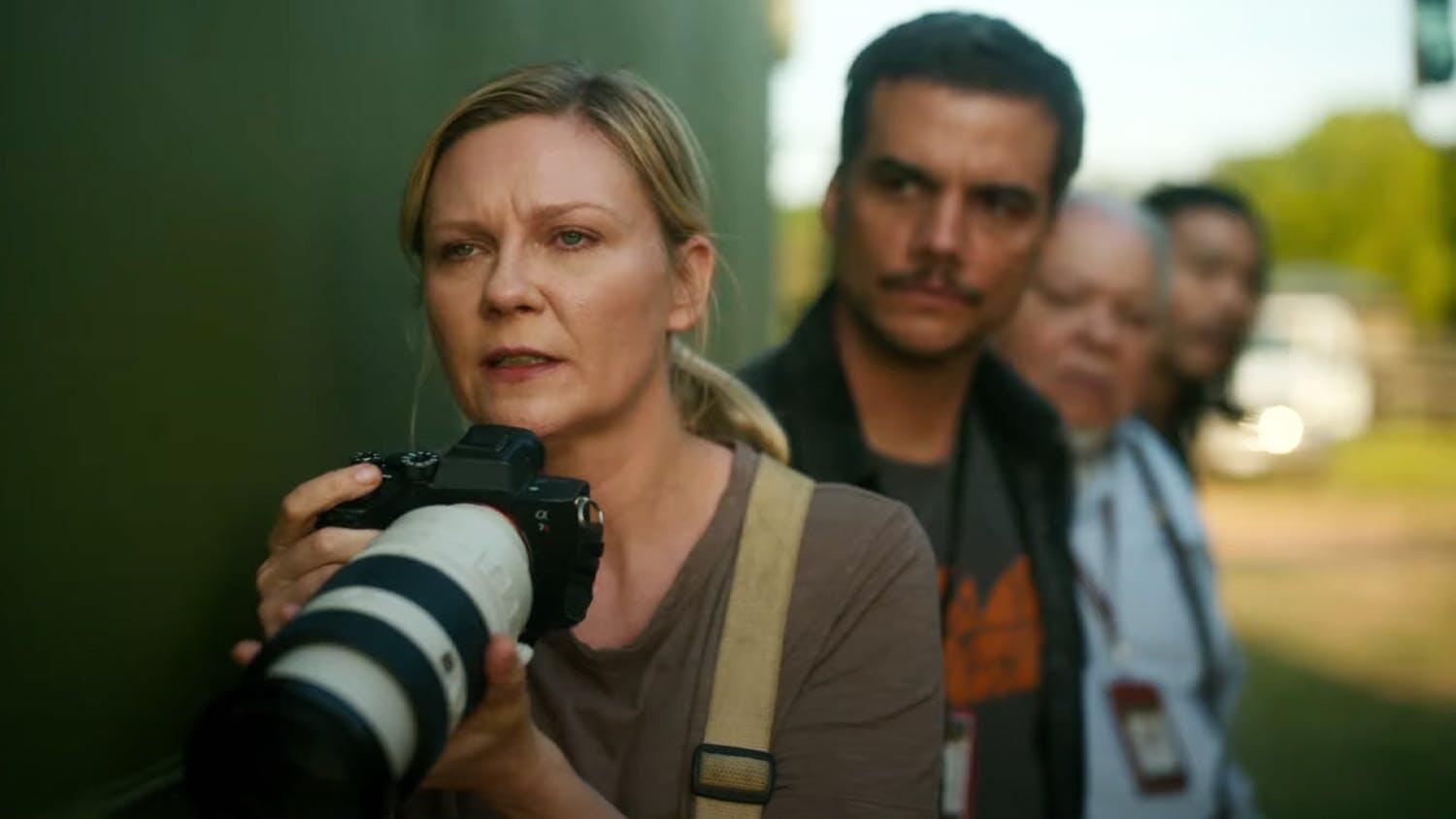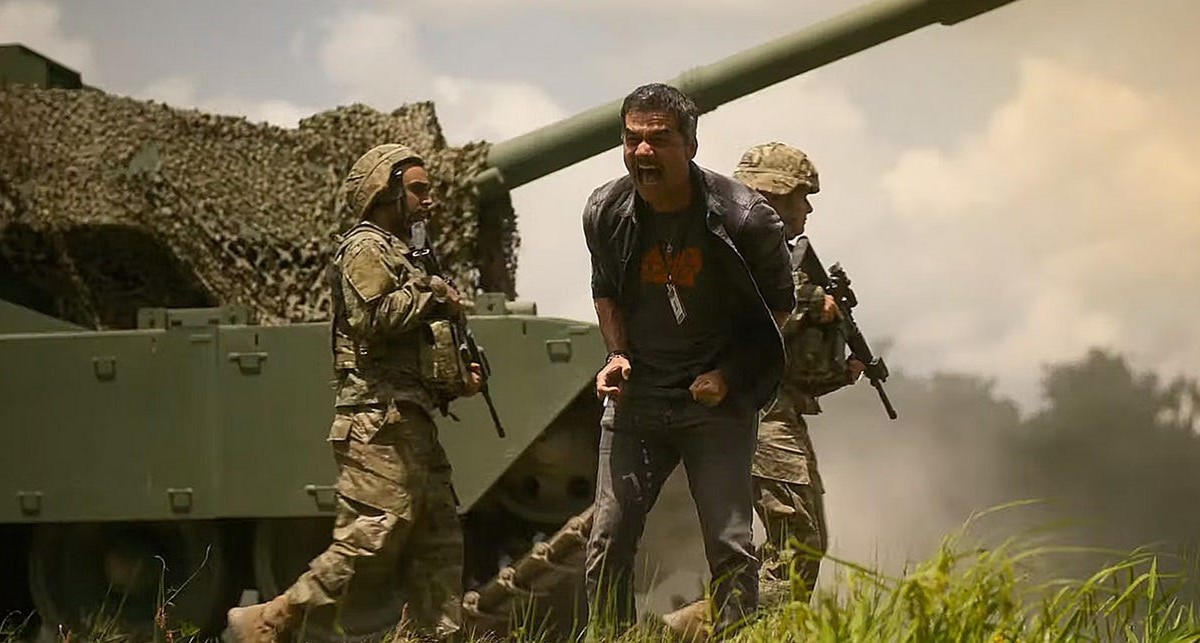Games People Play might have been another title for The Deer Hunter. The film was written by Deric Washburn (from a story by himself, the director, Michael Cimino, Louis Garfinkle and Quinn K. Redeker), and the steppingstones of his very long script are rituals—in normal and abnormal life, in peace and war. If the theme is decipherable, it’s that protocols, even the silly or the vicious ones, give design to life, confining perhaps but reliable. Washburn centers on a Russian-American community in a Pennsylvania mill town, presumably because their dense heritage provides solid examples of ritual. One rich ritual, a Russian Orthodox wedding, is the core of the opening section. Both the ceremony and the following celebration tell us a good deal about organization and hierarchy. At the drunken dance after the wedding, a man’s girl dances with another man, who gropes her behind without her protest. The first man intervenes and clouts the girl on the jaw.
The next set of rituals is a deer hunt right after the wedding, the last hunt for three men in the party before they go off to the Vietnam war. (Urban dwellers don’t realize how important hunting is to men in small towns and out in the country. One winter when I was a boy, I went on a two-day bear hunt with some farmers, and it was like a religious retreat, only with booze.) Again the ritual is explored both for its centrality— skill and enterprise—and for its periphery: a confrontation between two of the men over a pair of boots because the trappings of the ritual are part of the respect paid the ritual itself.
Then we cut to Vietnam and the capture of our three principals by the Viet Cong. There they are subjected to Russian roulette, made to place against their temples a revolver loaded with only one bullet and pull the trigger. This ritual becomes a test of hyper-macho courage: pulling the trigger not so much out of fearlessness as out of contempt for the people who are forcing you to play the game. Escape is maneuvered at last; but one of the three goes AWOL in Saigon.
The two others get back to Pennsylvania, one of them without legs. The unhurt man goes off on another deer hunt, but his experience has altered his relation to this ritual: a buck offers him a perfect shot, and the hunter declines. Then he goes back to Saigon, just as the United States is evacuating, to rescue the missing buddy. (This is where the relatively realistic script flops into Movieland.) In the midst of all the panic, he finds his friend in a gambling hideout, drugged to the gills, playing Russian roulette for high stakes and—finally—losing.
There are two concluding rituals: the dead man’s funeral back in his home-town church and another peripheral one, an impromptu mourning party in the bar that one of the hunting friends owns. Sitting around the table with their women, they drip slowly into a choric rendition of “God Bless America.” I don’t think the film’s intention here is ironic: they are all patriots, and they look on what they have undergone without bitterness, as part of the price of being American. The soppy song is a secular ritual of affirmation.
But my synopsis is, alas, more cogent than the film. The script doesn’t crystallize materials so clearly, doesn’t develop and “track” characters organically, and takes much too long—over three hours—to not do these things. Retrospectively, one can discern the attempt to build a structure of male rituals, to dramatize the role and status of men in contemporary America, a drama heightened by the fact that these particular men are still bonding in a European heritage. But experientially the picture drags, from one detailed examination to another, without cumulation: moving from intensity to incredibility to protracted finish.
Perhaps the film was lamed in editing, which is suggested by occasional bumps and uneasiness in the joins. But there’s small point in speculating that if the picture were longer, it would seem shorter. This paradox is possible, of course, but all we can judge by is what we’re shown.
And what we are shown is, in another paradox, exceptionally well made most of the time. I know the director, Cimino, only as co-author of a couple of scripts: Silent Running (with Deric Washburn) and a Clint Eastwood picture. Cimino’s work here is intelligently selective, shot by shot, with a true film-maker’s instinct for the right view of a given moment. His style is very much against heavy cross-cutting within a sequence: he likes to course, to move his camera within a sustained shot, picking up necessary elements serially, changing direction to follow a character’s movement—a style that has antecedents in such directors as Ophüls and Kurosawa and Jancsó. What Cimino needs is (as noted about Terrence Malick) the ability to “keep the picture in his head,” to be as clear about the whole organism at every moment as he is about the moment.
He already shows considerable ability with actors. Robert De Niro has a three-part role, three in one. He is one man before the war, another during the war, and the first man somewhat altered afterward. All are vivid, though Numbers One and Three (in an unappealing beard) make relatively small demands on him. The middle role, brimful of manic energy, is electric. It’s not De Niro’s fault, nor Cimino’s (as director, anyway), that the role has not been developed in depth throughout. John Savage, who was impressive on Broadway in David Mamet’s American Buffalo, is impressive again as the softest of the principal trio. Savage doesn’t so far show any “graspable” persona under his acting, any unique and individual personality to stamp him on our minds. Maybe a greater range of roles will reveal some richness. But he is certainly a good actor.
Christopher Walken, the third of the principals, has been hovering on the edge of something tremendous for a dozen years. The best work of his that I’ve seen has been in the theater, in Camus’s Caligula and Strindberg’s Miss Julie. Film has had difficulty in accommodating him. His best screen part before The Deer Hunter was the gigolo in Roseland. Here, as a mild man who in war gets frightened into a bravado that is not natural to him and that, after he deserts, he sustains with drugs, Walken is excellent. He does not have (to use the cant phrase) a face that the camera loves. Walken has to be photographed carefully, and, for the most part, the cinematographer, Vilmos Zsigmond, has done it. Walken is going to continue to be troublesome in films, as actor and as “face,” but he is worth the trouble. He’s so unusual, so talented, so widely ranging in fire and subtlety that he is both a challenge and an asset to film. The closest parallel I can think of is that wonderful Swedish actor Per Oscarsson (remember Hunger?), whom Walken resembles slightly. I hope that Walken will continue to combine stage and film careers and that film will find ways to use more of what he has already shown in the theater.
The Deer Hunter does exactly that with Meryl Streep. She, too, has an unconventional face and a big talent, both of which were poorly displayed in a small role in Julia. I’ve seen her many times in the theater, beginning with her student days, and have happily watched her develop —her voice, especially—until now she is one of the best young actresses in the country. Here she looks beautiful, uniquely so: Zsigmond does better with her Degas-Manet face than with Walken. Her performance has the stamp of confidence: in her actor’s imagination and in her ability to realize it completely for us. She plays a commonplace girl entirely credibly and, at the same time, makes her archetypal.
The music by Stanley Myers is sometimes laid on heavily—heavy quotations of folk-dance music when the men are out hunting to remind us what they come from—but it’s an evocative score as such. So many of the elements are so good that it all adds up to a pity. Someone, or more than one—writer or producers or director or editor or all—fogged up about why this picture was being made and whether it was on the rails. Once more Eliot applies, paraphrased: between the idea and the reality fell the shadow.
(New Republic, December 23 & 30, 1978)
* * *
The furor over The Deer Hunter is international, heightened by its Academy Awards. “Racist,” “a criminal violation of the truth,” “a continuation of [the Vietnam] war by other, and more profitable, means” —these are some of the comments. In London the New Statesman ran an article called “Why The Deer Hunter Is a Lie” and illustrated it with juxtaposed photographs: a napalmed Vietnamese child and a publicity shot of the film’s principal actors, smiling. (The New York Times subsequently published an adaptation of that article on its Op-Ed page.) In Berlin this spring the Soviet Union and its satellites withdrew from the Film Festival there because The Deer Hunter had been included. Aside from the Soviet-bloc action—how can it be anything but gruesomely funny to see them protesting alleged dishonest propaganda?—the controversy, which continues, is important and worth examining.
I begin with myself because, in candor, I was surprised by the reaction to the film in some quarters, and my surprise is connected to my argument. Early in the 1960s I joined the protests against American involvement in Vietnam, kept protesting as that involvement grew, and kept on after the withdrawal of American troops while money and supplies continued to flow to Vietnam. I mention my actions, which were no more than what thousands of others did, only to “place” myself on the subject. And to me, the torture sequence in The Deer Hunter—the Viet Cong forcing their American prisoners to play Russian roulette—did not seem intrinsically incredible: because neither I nor anyone I knew objected to the Vietnam war on the ground that the North was angelic. We knew fairly early of the tortures and murders done by South Vietnamese and United States forces, but we also knew of tortures and murders done by the North Vietnamese. The issue for us was American intervention—its effects there and at home—not the moral superiority of North over South Vietnam. Thus when I saw this fifteen-to-twenty-minute torture sequence in the middle of this three-hour film, I took it as given. I had no knowledge as to whether the Russian-roulette routine had ever actually been practiced (and much has since been made by ex-correspondents of the fact that they never heard of it there), but I accepted it as symbolic, for two reasons.
First, the Viet Cong were quite capable of barbarism and the killing of prisoners. Does anyone doubt that? Second, the sequence fits the film, thematically and metaphorically. The Deer Hunter is not about Vietnam: it’s about three steelworkers, bonded in maleness, who work and drink and hunt together, who enlist together as paratroopers, who are captured and tortured together, who escape together, and who then—which is usually omitted in comment—move on to the longest part of their story, the differing resolutions of that experience with their futures. They do not see the war as other, embittered, horrified or numbed soldiers saw it, or as I saw it, or, for that matter, as Jane Fonda saw it: they see their war. The Russian roulette was the obvious extension of the “one shot” credo by which these former hunters had lived; enlistment in war and survival of torture were the testings in extremis of their maleness. I was so convinced of this—and still am, after seeing the film again—that I suggested the alternative ironic title Games People Play.
So I was surprised that some intelligent people—I disregard the loud-mouthed opportunists—have seen the film otherwise. The Vietnam experience, in all its ramifications, was a wound from which this country may never recover, worse in some ways than either of the World Wars; perceptive people are understandably sensitive about it. Still their reaction here seems odd: the objection seems to be not so much that the VC are shown as vicious but that the ARVN and U.S. forces are not also shown as vicious, maybe more so. This seems to me an inhibiting, almost juvenile critical equation: If we show bad actions by people with whom we sympathize, we must at least balance them with bad actions by people with whom we don’t sympathize. Did these critics also object to Slaughterhouse-Five, novel and film, because it showed the Allied fire-bombing of Dresden but did not show the German bombing of Coventry? (The New Statesman article, mentioned earlier, detailed the indisputable sufferings of the North Vietnamese, with very little comment on the film itself, as if the omission of those sufferings self-evidently discredited the film.)
Philip French, the film critic of the (London) Observer, wrote the most succinct and just comment on The Deer Hunter that I have seen (March 4, 1979). He noted the title’s link with Fenimore Cooper and the relation in themes and situations with some Hemingway stories, then said:
The picture is about that perennial American preoccupation . . . with male friendship, seen as a finer and stronger thing than love between men and women. And it’s about the other side of that coin, loneliness, the brooding cosmic solitude Americans have felt ever since they confronted the overpowering vastness of their continent. . . . The Deer Hunter deals with an ethnic community largely untouched by the great social currents of the 1960s and is constructed quite deliberately to eliminate discussion of war-aims and the larger issues involved in the Vietnam conflict. This is a grave weakness (some will think it an invalidating one), but it is also what enables Cimino [the director] to attain something approaching the tragic grandeur of a popular epic.
(French was then subjected—in the New Statesman again—to a vile versified attack based on one line slyly extracted from his review.)
For myself, I don’t agree with one point, that it was arbitrarily a weakness to eliminate discussion of the larger issues and was therefore a mistake to concentrate on machismo. Also, I put aside the argument, of which much has been made by others, that The Deer Hunter is suspect because Cimino possibly inflated autobiographical statements in interviews. Of what relevance is that to the film itself? If autobiographical impeccability were a prerequisite in a director, we would have to discard all of Erich von Stroheim. And I also think the accusation, by some, that Cimino chose his subject as a way to “win” the war retroactively is weak. It indicts him not for villainy but for economic and artistic lunacy: it says that he made the other two hours and forty minutes of the film only to enclose his twenty minutes of “message.”
I submit that, if we are going to be moved to thought and action by The Deer Hunter, it ought to be by the implications of its true subject: the limitations for our society of the traditions of male mystique, the hobbling by sentimentality of a community that, after all the horror, still wants the beeriness of “God Bless America” instead of a moral rigor and growth that might help this country.
None of the above is to say that The Deer Hunter is a first-class film, as such. It is not. Although the direction is generally good and the acting is always fine, the script flounders increasingly as it goes on, particularly in the third and longest section. The extraordinary acting is what holds the film together when the script straggles. Still, it ought to be slated for its real faults, not for adduced ones. Anyway, with further irony, The Deer Hunter is a much better piece of work, in artistic wholeness and thematic cogency, than Coming Home, that flabby and compromised picture on the Vietnam war made by people whose political views are, apparently, close to my own.
But the sharpest irony of all this outcry against The Deer Hunter is that it has further obscured the best film so far made about Vietnam. Go Tell the Spartans is really about the Vietnam war, in 1964; and, beneath some stock war-movie ingredients, it deals ruthlessly with the making of the quagmire. Instead of lambasting The Deer Hunter for supposedly doing something outside its subject, instead of praising Coming Home for what it fiddled with, it would be a lot more to the point to pay some attention to Go Tell the Spartans, which virtually no one has seen.
(New Republic, May 26, 1979)





